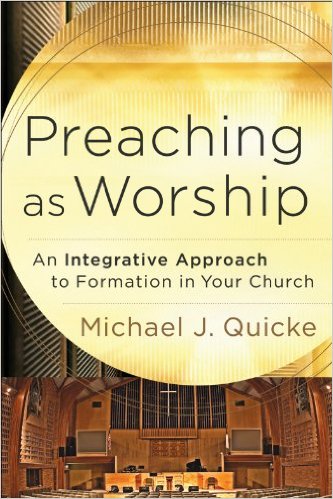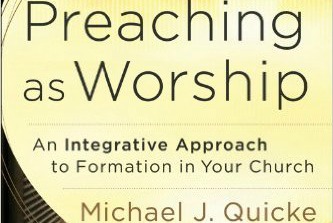How might Catholic parishes better form worshippers in, through, and for liturgy?
Michael Quicke’s Preaching as Worship: An Integrative Approach to Formation in Your Church provides insight into this question from a decidedly different perspective than the usual approaches from liturgical and sacramental theologians, pastoral practitioners, or even parish councils. Quicke provides an honest and self-reflective pitch for understanding preaching as worship from the perspective of his ministerial experience in predominantly Baptist churches in the United Kingdom and the United States—what many might call a “nonliturgical background,” though he accurately acknowledges that even informal worship patterns create liturgical forms (14).
As a professor of preaching at Northern Seminary (Lombard, Illinois), Quicke was deeply influenced by key architect of “ancient-future” worship theology Robert E. Webber’s call to renew “shallow” evangelical worship that was dominated by the pastor with the congregation as “little more than audience,” and devoid of mystery, a “lecture-oriented, music-driven, performance-centered, and program-controlled model” (15–16).
 In this work, Quicke unpacks his own reexamination of principles and practices as a preacher in light of Webber’s call for a “God-centered perspective on worship” (15). His goal is to help preachers “restore worship as an encounter with God” (20). At its essence, this “preaching as worship” (what Quicke also calls “big-picture” preaching/worship or the opposite of “myopic” preaching/worship) is characterized by preaching relocated “within worship [rather than superior to it], with theological, spiritual, and practical integrity” (21).
In this work, Quicke unpacks his own reexamination of principles and practices as a preacher in light of Webber’s call for a “God-centered perspective on worship” (15). His goal is to help preachers “restore worship as an encounter with God” (20). At its essence, this “preaching as worship” (what Quicke also calls “big-picture” preaching/worship or the opposite of “myopic” preaching/worship) is characterized by preaching relocated “within worship [rather than superior to it], with theological, spiritual, and practical integrity” (21).
Quicke brings the reader through his call to action in three parts. In Part 1, “From a Small Picture of Worship,” he reflects on why preachers are not interested in worship and identifies ten characteristics of deficient preaching that ignores the implications of big-picture worship. Next, in Part 2, “Toward a Bigger Picture of Worship,” he examines what a robust theology of worship necessarily implies for preaching, how Scripture directs preaching and worship patterns, the potential impact of the Christian [liturgical] year and lectionary, and the missional theology and dynamics of community formation. Finally, in Part 3, “A New Process,” Quicke proposes concrete ways for preachers to collaborate with other worship leaders to plan worship, while setting and evaluating outcomes of big-picture worship in the local church.
Engagement with Preaching as Worship largely depends on one’s own place, experiences, and formation along the wide spectrum of Christian worship. For those rooted in American evangelical, Pentecostal, or “free” traditions of worship, Quicke’s approach, process, and descriptions are immediately relevant, with direct references to the inner dynamics of senior pastor and worship leader working relationships, common trends and tensions in worship planning, and introduction to the depth and history of theology and Christian practices that “indissolubly link” preaching and worship (27).
For those approaching Preaching as Worship from what are often considered “more liturgical” backgrounds, moving through Quicke’s process requires humble patience, as there are few direct, practical references that reflect the pastoral realities in liturgical churches. For those formed in courses on sacramental or liturgical theology, Quicke’s introduction to a theology of worship may seem unexciting. Yet by exploring and adopting Quicke’s principles, highly applicable insights for liturgical congregations do also emerge.
For example, as a Roman Catholic, while it may be tempting to read Preaching as Worship and think that Catholic parishes are immune from small-picture worship because of the Church’s rich liturgical theology, the sacraments, and more, the reality is that merely possessing liturgical texts and rubrics is not enough to ensure that worship is truly big-picture and preaching is truly worship. A liturgical church could consider the following characteristics of small-picture worship in a liturgical setting as an examen:
- Are some leaders or members of your church community so discouraged by the legacy of poor preaching that that they have failed to expect God to speak in the sermon or tend “to minimize the sermon by over-stating the place of sacraments?” (30)
- Are there leaders or participants in your church who define “worship” as music only, liturgics only, maintenance only, or Sunday services only? Would some respond to the question, “what is worship?” with a blank stare? (40–43)
- Does the music and/or liturgy coordinator only receive the sermon topic or theme a week before the service? Does “isolation [in worship and preaching preparation] rule instead of collaboration” when it comes to the preacher and other ministers in the congregation? Do preaching, worship, and the life of the congregation speak the same message? (58)
- Have liturgical practices rich with mystery, dynamism, and encounter with God become “caught up with forms that become too routine, with little opportunity for extempore or fresh, multisensory experiences” as perceived by the congregation? (100)
Affirmative answers in any of these areas are likely a symptom of myopic, small-picture worship even in faith traditions with a strong history and culture of liturgical worship. Quicke places leadership responsibility with preachers, who must have the honesty and courage to take action. He notes, “I have met several experienced pastors who honestly admitted they were guilty of myopic preaching, but they balked at dealing with inevitable resistance arising from entrenched worship habits. They rejected trying to lead even small breakthroughs because it might prove costly” (179). As part of the New Evangelization, we all must ask Quicke’s challenging question, are we resisting small breakthroughs to move beyond myopic preaching and worship because of the cost and effort?
The most thought-provoking, practical contribution Quicke offers for those in liturgical churches is his framework for integrating elements of community formation into preaching. Quicke describes four stages of community formation: initiation, integration, character formation, and missional living. For Catholics, the “initiation” stage goes beyond an external correlation to the sacraments of initiation and is instead a stage where preaching is evangelistic so as to challenge hearers to “make faith-responses to Christ” and then “grow into congregational life by developing big-picture worship” (162). It is the essential foundation for all further community formation. Stage 2, “Integration,” is where liturgical and salvation history preaching take center stage—“Christian we-ness” is emphasized and the spiritual disciplines of offering money as an act of worship (rather than a “pragmatic necessity”) and responding well to sermons through preparation in prayer, practiced willingness, and active listening are cultivated (165). The third stage, “Character Formation,” requires pastoral preaching and leadership through preaching in order to “help the whole community grow in its responsibility to support and care for its members and those outside” while dealing with “real-life issues” that arise from the growth of a truly corporate identity (170). Stage 4, “Missional Living,” is when the community is moved “beyond maintenance to missional mode” (173). Preaching in this stage is both prophetic and mission-oriented.
Quicke’s framework provides a concrete reminder that community formation must build progressively on a solid foundation. In far too many parishes, the presumption is that because most of the congregation has received certain sacraments, they are automatically in the “character formation” or “missional living” stages of community formation—regardless of an explicit faith-response to the Gospel or cultivation of spiritual disciplines expectant listening, big-picture worship, or spiritual giving.
Unfortunately, one of the most disappointing moments of Preaching as Worship comes when Quicke acknowledges that he will not be exploring “just how do preachers address a community that comprises worshipers at different stages? Is it possible to challenge newcomers with gospel basics while nurturing established worshipers into missional living?” (174). This situation is precisely the one that many Catholic parishes face. Nevertheless, those interested in deliberately anchoring and reinforcing a clear pathway of discipleship in and through liturgical preaching will find this a helpfully provocative read.



